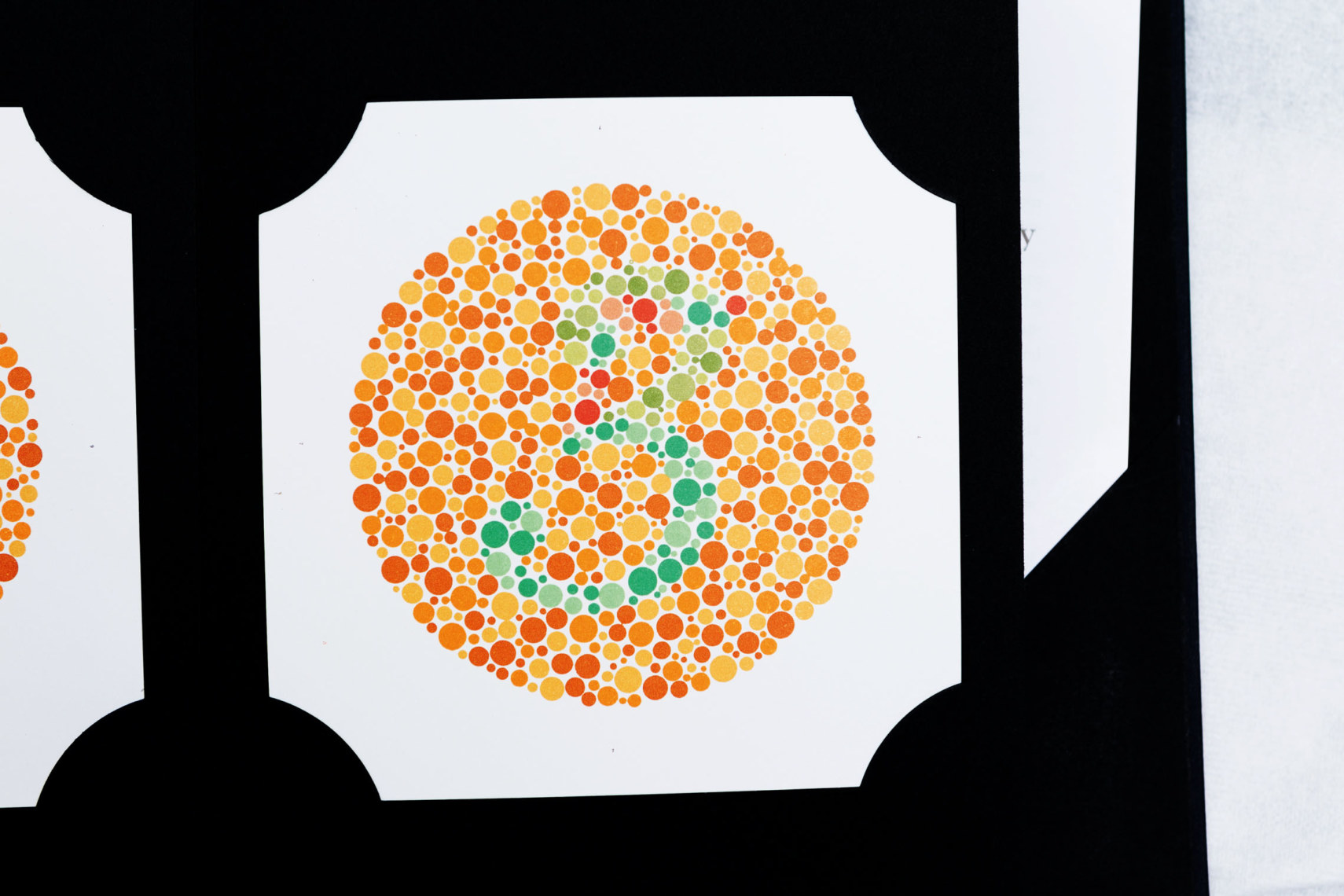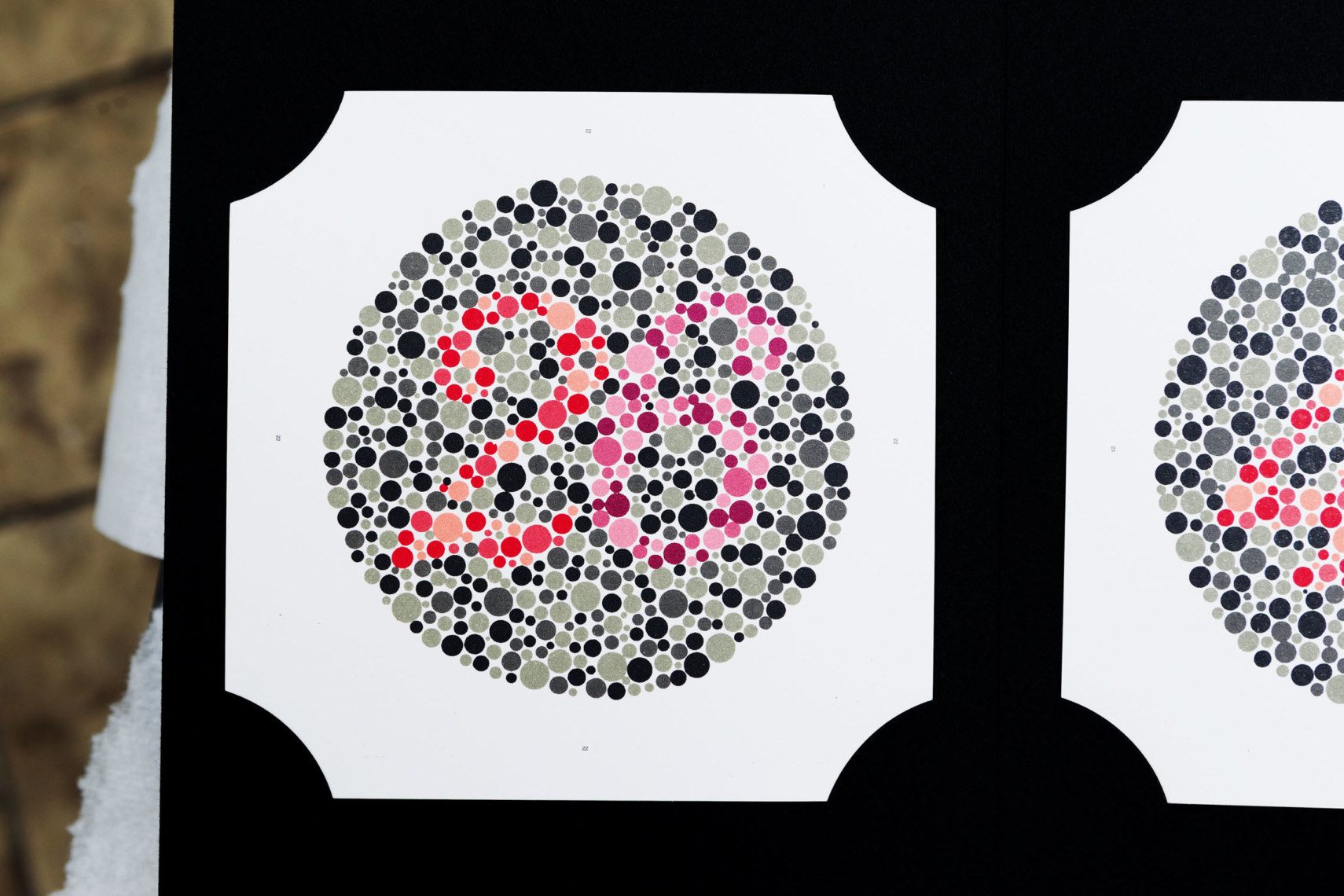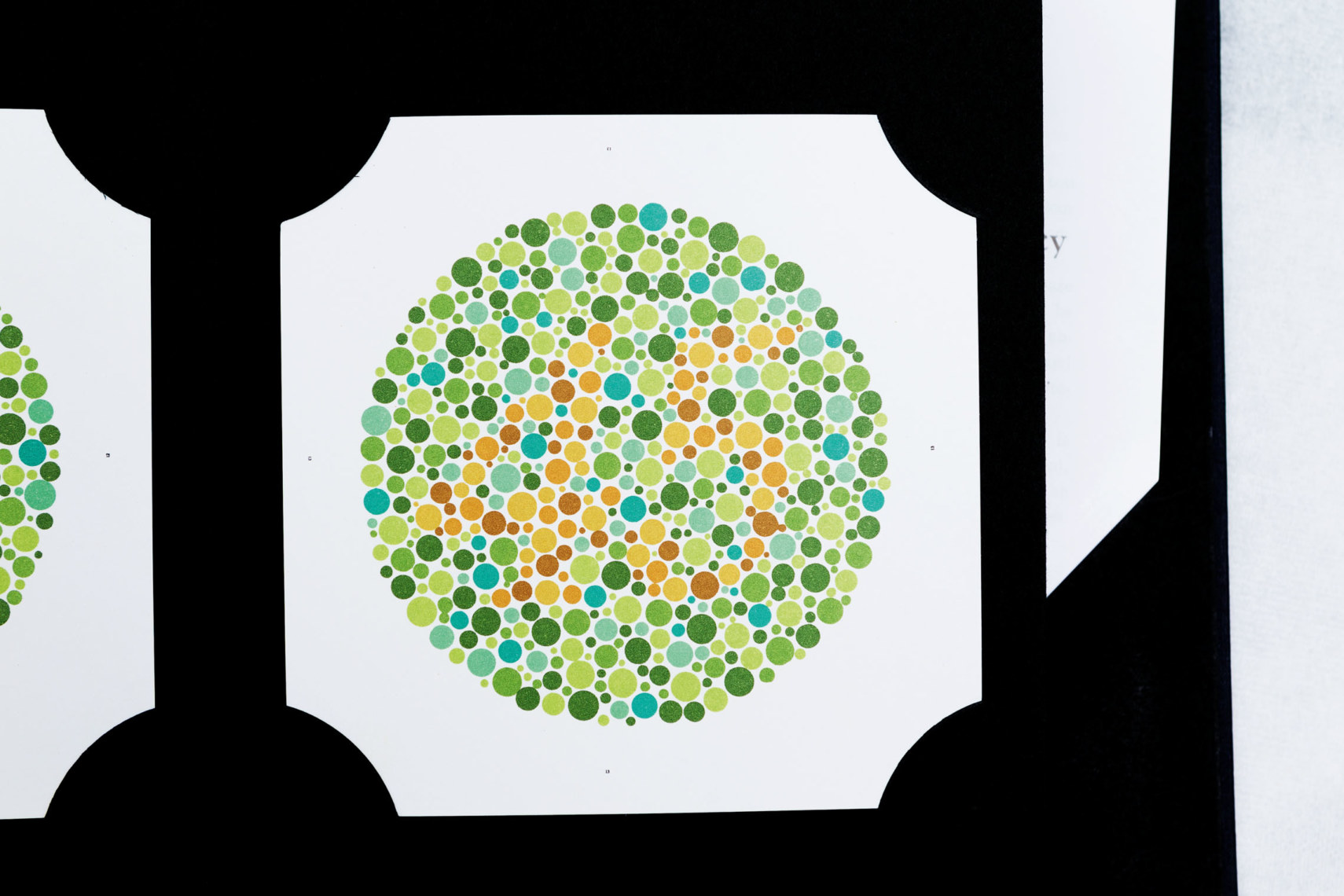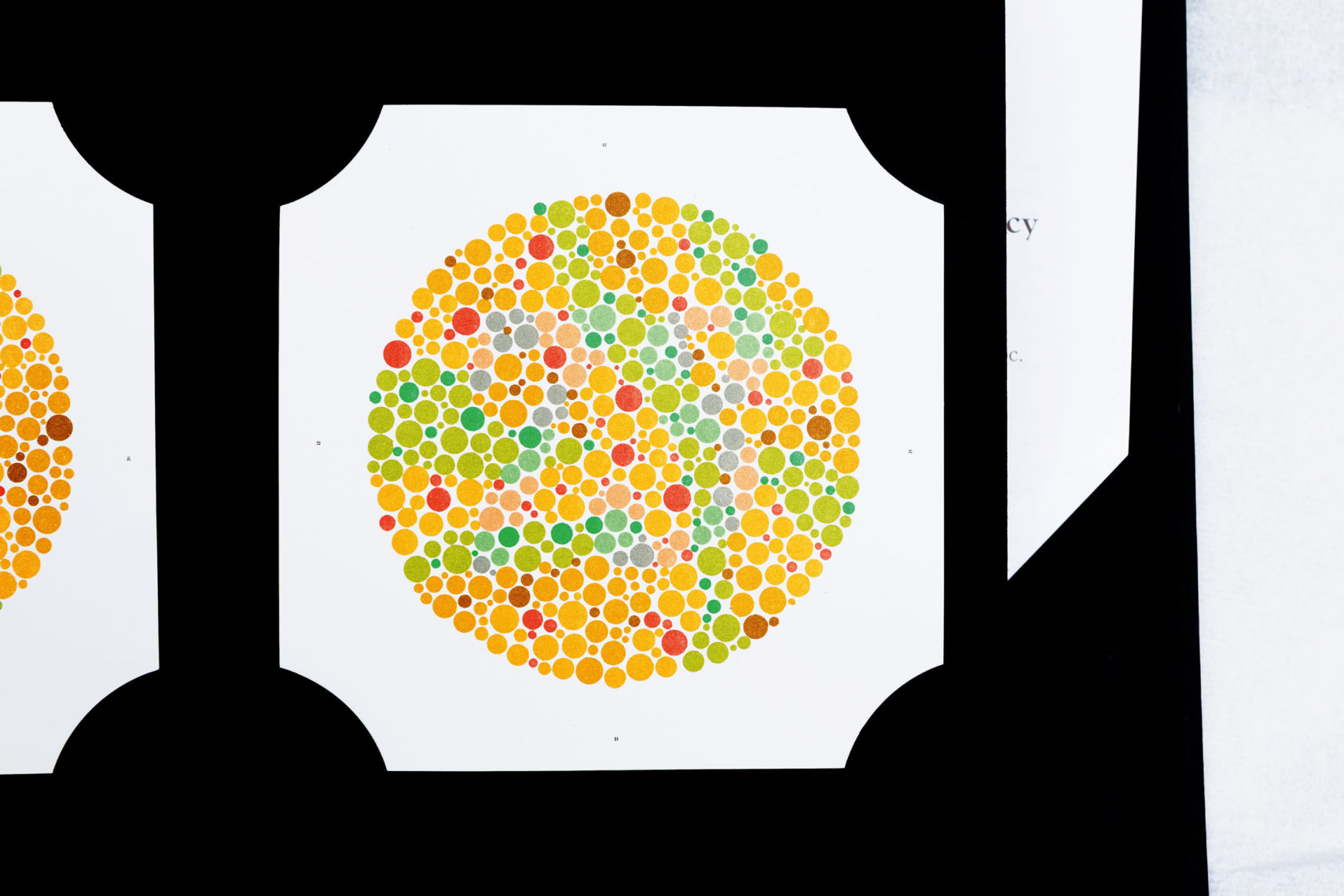All a Question of the Ingredients
Yet the beginning of this colorful process is grey theory. Every formulation has a batch card that contains the color specification. This is based on color values provided by the vehicle manufacturer. So the head of pre-series development withdraws to his office—affectionately known as the “shed”—and analyzes the data on the computer.

Color engineer Ralf Henkelmann knows what color values he has to store on his computer to achieve the result he wants to see later in the light studio.

Henkelmann inspects color panels and the original sample in the light studio.
There he compares the values from the last batches—if any—and then determines the ingredients, i.e., which quantities of which color pastes need to be added to the formulation.
He is aided in the process by a color tone navigator—software that calculates color tones. But because there is no data for most colors in the pre-series phase that could be used as a basis for calculation, the expertise of the color engineer is indispensable.
Henkelmann assesses to what extent he needs to adjust the manufacturer’s specification in order to achieve the perfect result.
For 882 pounds (400 kilograms) of “Black Ruby,” for example, the specialist calculates: 6.6 pounds (3 kilos) of black, 14.3 pounds (6.5 kilos) of red, 8.4 ounces (240 grams) of blue, and 29.6 ounces (840 grams) of white. Although the quantities appear relatively large, every gram counts. In the end, it’s nuances that decide whether the mix will deliver the desired result.
The number of pastes also varies depending on the paint. “In the automotive field, we use up to eight color pastes per color; the average is five or six.”
Chemistry is Alive
Henkelmann notes the quantity specifications on the color chart and passes it along to colleagues. They then start mixing. Every paste is weighed precisely, filled, and then thoroughly stirred in movable containers for a good 30 minutes. Then the first sample painting is carried out. For an optimal result, Wörwag simulates the customer application—i.e., the manner in which the manufacturer coats its components.

Color pastes are added according to his calculations, precise to the gram.

Once all the pastes are in, the mixing begins. The pastes are stirred in large, moving containers for 30 minutes.
You might think that once a color is determined, it could be used repeatedly thereafter. Not true! The reason: variations in the raw materials and applications ensure that in pre-series development every color and every batch has to be reconstituted from the ground up.
“Chemistry is alive,” sums up Henkelmann cogently. His job therefore requires a good deal of experience. And he has plenty of it. The trained painter has been working as a color engineer with Wörwag in Stuttgart-Zuffenhausen since 1989.
The specialist remembers the early days well: “Daimler was the first carmaker to paint plastic components in colors. It started with just three or four colors back then.” Now some 15 to 20 paints go through his department every day.
Color has always been his passion. And it’s apparent. His enthusiasm is infectious, and colleagues seek his advice with some regularity. On his way through the production halls, several employees grab his attention: “Ralf, quick question …”
Although he’s usually under deadline pressure, he takes the time to help colleagues. Henkelmann has excellent instincts—for colors as well as for people. Important prerequisites for a man in his position. “More important than the formal prerequisites,” as he says.
Color Lovers and Team Players
For starters, a color engineer has to be able to recognize all colors. Ishihara color perception tests, which rule out red-green color deficiencies, among other things, are an integral part of the suitability test. Moreover, all color engineers have to take the Munsell test (see box on page 37). It’s a serious challenge. Yet Henkelmann says this: “Good color perception doesn’t make you a good color engineer,” he says, and reiterates the importance of natural talent.

Over and above this, color engineers have to demonstrate their color-judging acumen through the Munsell test as well (image below). This consists of four rows with a total of 85 removable color chips. The object of the test is to arrange two rows of chips with the hues in the correct order. The test is administered upon hiring and must be repeated regularly. It has been used for 50 years in quality control measures in the industry, but is also used in public agencies and schools.

With the BYK-mac-i, Henkelmann measures color values of the test-painted color panels.
Many have tried their hands and failed. There isn’t really a specific education for it.
Special professional qualifications don’t exist, either. Having worked as a painter or in chemicals really makes no difference—it’s all about the talent. “When I notice that someone is a good fit for the job, I’m happy to pass on my knowledge about it,” says Henkelmann.
Prospective color engineers follow the master in lockstep, observing, learning and trying themselves. It takes at least three years to master the subject. The further procedure of coloring illustrates why. Some three hours after the first color panel was test-painted with the newly formulated color, it lands on Henkelmann’s desk. Time for the BYK-mac-i.
Behind what appears to be an afternoon snack is actually a high-tech measuring device. Placed on the color panel, it determines the color values using six different angles, of which the plan view (45 degrees), sloping view (75 and 100 degrees), and gloss reading (15 and 25 degrees) are evaluated.
The measurement procedure takes about a minute. Henkelmann then compares the actual values with the target values of the color specifications. To some extent, he’s the Lord of the Numbers as well. Yet even when the figures are within the tolerances specified by the manufacturer, the goal has still not been achieved. Only when a color panel passes both the visual check and the quality check is it released for approval by the customer.
On the Trail of the Color Specification
So Henkelmann makes his way back to the light cabinet. He moves around quite a bit in the plant. He likes to stay active in his private life as well. His favorite activity is to hike in the mountains with his wife. Their longest tour took the two of them from Munich across the Alps and the Dolomites to Venice. “22,000 meters in altitude just going up in four weeks—it was phenomenal!” Nature provides recuperation and inspiration.
Nowhere, he says pointing his outstretched arm toward the window, are there more beautiful colors than in nature. “The evening sky … dawn … fall colors … I could sit on a hill for hours just gazing at the forest.”
At the light cabinet, he inspects color panels and the original sample in the light studio. “After the first test paint, we’re generally about 80 percent of the way there,” he explains.
On average, there are about four to five color steps per batch. Within ten working days, the paint color should be ready. In German, the light studio, Willingraum, is named for engineer Achim Willing, who developed the room for visual color evaluation for add-on parts together with Daimler.
Because so many carmakers approve their painted components in this manner, visual inspection is extremely important in the field. There are also three light cabinets next door. The light cabinets make it possible to configure the different types of lighting and simulate the effect of a paint color during the day or under a streetlight.
Like the BYK-mac-i, Henkelmann observes the panels in plan, sloping, and gloss views. “I never look at a color panel for more than 30 seconds,” he reveals, adding: “and I always check light colors first, and colors like red at the end. Doing it the other way around would falsify the results.” Then even he wouldn’t notice that he has to take a bit of blue out of the yellow.
Do you have what it takes to be a color engineer?
Did you see the numbers in the color circles below? 3, 26, 45 and—nothing. In the final circle, you shouldn’t see any number. These are Ishihara color charts. They are used to test whether someone suffers from a red-green deficiency, for example—an absolute disqualifier for a color engineer.
To test this, the motifs are made up of different-colored and different-sized dots. People with normal color perception can see the numbers in them. People with color blindness have a hard time seeing them or do not see them at all.
In western countries, 9% of men and 0.8% of women have a red-green deficiency. The test method was developed by the Japanese ophthalmologist Shinobu Ishihara. He developed the test images in 1917.
Get it all? We’re looking for color engineers—and others
For more information about the career of color engineer, contact Uwe Ortmann, e-mail: uwe.ortmann@woerwag.de. All open positions are listed on our website at www.woerwag.com/jobs.
Photos: Florian Imberger
Text: Thorsten Schönfeld




